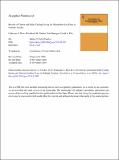Files in this item
Records of carbon and sulfur cycling during the Silurian Ireviken Event in Gotland, Sweden
Item metadata
| dc.contributor.author | Rose, Catherine | |
| dc.contributor.author | Fischer, Woodward W. | |
| dc.contributor.author | Finnegan, Seth | |
| dc.contributor.author | Fike, David A. | |
| dc.date.accessioned | 2019-11-26T00:36:26Z | |
| dc.date.available | 2019-11-26T00:36:26Z | |
| dc.date.issued | 2019-02-01 | |
| dc.identifier | 250641231 | |
| dc.identifier | 483b3e60-16b8-420c-9aae-7f558dbd979a | |
| dc.identifier | 85058235771 | |
| dc.identifier | 000455651400015 | |
| dc.identifier.citation | Rose , C , Fischer , W W , Finnegan , S & Fike , D A 2019 , ' Records of carbon and sulfur cycling during the Silurian Ireviken Event in Gotland, Sweden ' , Geochimica et Cosmochimica Acta , vol. 246 , pp. 299-316 . https://doi.org/10.1016/j.gca.2018.11.030 | en |
| dc.identifier.issn | 0016-7037 | |
| dc.identifier.other | ORCID: /0000-0001-8149-0977/work/51261127 | |
| dc.identifier.uri | https://hdl.handle.net/10023/19002 | |
| dc.description | Field and stable isotope work was supported by an Agouron Institute grant to DAF and WWF as well as a Packard Fellowship and a Hanse-wissenschaftskolleg Fellowship awarded to DAF. | en |
| dc.description.abstract | Early Silurian (∼431 Ma) carbonate rocks record a ca. 4.5‰ positive excursion in the stable isotopic composition of carbonate carbon (δ13Ccarb). Associated with this isotopic shift is a macroevolutionary turnover pulse known as the ‘Ireviken Event’. The onset of this carbon isotope excursion is commonly associated with a shallowing-upward facies transition that may have been accompanied by climatic change, as indicated by a parallel positive shift (∼0.6‰) in the stable isotopic composition of carbonate oxygen (δ18Ocarb). However, the relationships among carbon cycle perturbations, faunal turnover, and environmental changes remain enigmatic. Here we present a suite of new isotopic data across the Ireviken Event from multiple sections in Gotland, Sweden. These samples preserve no systematic change in δ18Ocarb but show positive excursions of equal magnitude in both carbonate (δ13Ccarb) and organic (δ13Corg) carbon. In addition, the data reveal a synchronous perturbation in sulfur isotope ratios, manifest as a ca. 7‰ positive excursion in carbonate-associated sulfate (δ34SCAS) and a ca. 30‰ positive excursion in pyrite (δ34Spyr). The increase in δ34Spyr values is accompanied by a substantial, concomitant increase in stratigraphic variability of δ34Spyr. The relatively constant offset between the δ13Ccarb and δ13Corg excursions throughout the Ireviken Event could be attributed to increased organic carbon burial, or possibly a change in the isotopic composition of CO2 sources from weathering. However, a positive correlation between carbonate abundance and δ13Ccarb suggests that local to regional changes in dissolved inorganic carbon (DIC) during the shallowing-upward sequence may have been at least partly responsible for the observed excursion. The positive excursion recorded in δ34SCAS suggests a perturbation of sufficient magnitude and duration to have impacted the marine sulfate reservoir. An inverse correlation between CAS abundance and δ34SCAS supports the notion of decreased sulfate concentrations, at least locally, consistent with a concomitant increase in pyrite burial. A decrease in the offset between δ34SCAS and δ34Spyr values during the Ireviken Event suggests a substantial reduction in the isotopic fractionations (εpyr) expressed during microbial sulfur cycling and pyrite precipitation through this interval. Decreased εpyr and the concomitant increase in stratigraphic variation in δ34Spyr are typical of isotope systematics observed in modern shallow-water environments, associated with increased closed-system behavior and/or oxidative sedimentary reworking during early sediment diagenesis. While the isotopic trends associated with the Ireviken Event have been observed in multiple locations around the globe, many sections display different magnitudes of isotopic change, and moreover, are typically associated with local facies changes. Due to the stratigraphic coherence of the carbon and sulfur isotopic and abundance records across the Ireviken Event, and their relationship to changes in local depositional environment, we surmise that these patterns more closely reflect biogeochemical processes related to deposition and lithification of sediment than global changes in carbon and sulfur burial fluxes. | |
| dc.format.extent | 18 | |
| dc.format.extent | 2722049 | |
| dc.language.iso | eng | |
| dc.relation.ispartof | Geochimica et Cosmochimica Acta | en |
| dc.subject | Carbonate-associated sulfate | en |
| dc.subject | Pyrite | en |
| dc.subject | Silurian | en |
| dc.subject | Sulfur isotopes | en |
| dc.subject | GE Environmental Sciences | en |
| dc.subject | DAS | en |
| dc.subject | SDG 14 - Life Below Water | en |
| dc.subject.lcc | GE | en |
| dc.title | Records of carbon and sulfur cycling during the Silurian Ireviken Event in Gotland, Sweden | en |
| dc.type | Journal article | en |
| dc.contributor.institution | University of St Andrews. School of Earth & Environmental Sciences | en |
| dc.identifier.doi | 10.1016/j.gca.2018.11.030 | |
| dc.description.status | Peer reviewed | en |
| dc.date.embargoedUntil | 2019-11-26 |
This item appears in the following Collection(s)
Items in the St Andrews Research Repository are protected by copyright, with all rights reserved, unless otherwise indicated.

